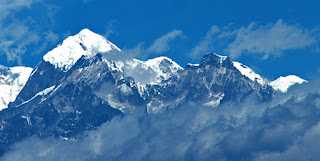Lhotse is connected to Everest via the south col and is the fourth highest mountain in the world. The main summit is 8516 m while Lhotse Middle (east) is 8414 m and Lhotse shar is 8383 meters. It lies at Solukhumbu district. Very often climbers making an attempt on Everest, go up the Lhotse to acclimatize. In fact, the usual route leading to Everest starts up the North West face of Lhotse and then cuts across to the more famous mountain.
An early attempt on Lhotse was made by the 1955 International Himalayan Expedition. They climbed up the west Camp and the North West face of Lhotse reaching an altitude of 8100 m. They were beaten back by unexpectedly strong wind and cold temperatures.
The first to the Lhotse summit were Swiss team of Ernst Reiss and Fritz Luchsinger from the Swiss Mount Everest/Lhotse Expedition on 18th may 1956. And Lhotse shar was Summitted on 12th may. The first Nepali to reach the Lhotse summit was Urkien Tshering Sherpa on 8th may 1977.













